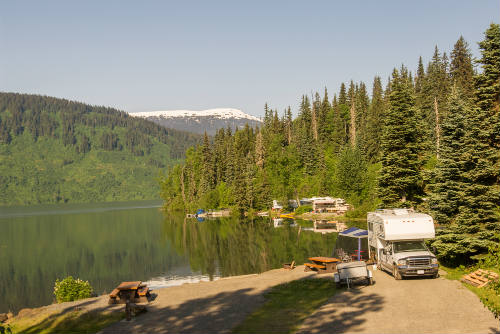What We Learned About RV Length Restrictions Before We Shopped
It’s a logical question that did not dawn on us the first time we went out shopping for the RV we had been dreaming about: Is there an ideal RV length? Campground rules are different and require RV owners to do their homework, just as we did.
According to NationalParksTraveler.org, some new RV owners assume all they need do is pull up, pay a fee, park, and commune with Mother Nature.
That’s what we thought too. But we quickly learned that some campgrounds have been hosting RVs since Eisenhower was in office, so not every space suits every RV. In other words, an ideal RV length is subject to interpretation!
We didn’t have to join the RV Repair Club to begin our education. Their video got us off to a great start:
Understanding the diversity, we would find find from coast-to-coast was a great way to start our grand adventure.
Does Length Equate to Features? Not These Days
Although some RV shoppers are guided strictly by their budgets, we weren’t. But from the get-go, we realized that we had to solve “the class riddle” to figure out which type of vehicle was right for us.
In fact, today’s designs are so sophisticated, it’s possible to live like royalty in an RV that’s shorter than you may first have imagined. That stated, here’s what we discovered about class distinction:
Class A RVs are considered motor homes because they’re built on a special type of chassis. These vehicles may be equipped with slide-out sections that can dramatically alter the width measurements you take when determining size parameters.
Class B RVs, also known as van campers, tend to have silhouettes that look “slightly stretched.” These vehicles and may also have raised roofs. Today’s Class B RV is engineered to fit into typical parking spaces, which is why we chose this style for ourselves once we completed our homework. Our salesperson convinced us of the wisdom of this choice and who were we to ignore his advice?
Class C RVs are easy to spot thanks to this model’s distinct cab-over bunk. Available in varying lengths and often featuring slide-out rooms, this type of vehicle should fit most campground slots and some RV newbies swear that the Class C is trendy and becoming more popular by the day–especially for retirees.
By the Numbers
According to BuildingsGuide.com, the average height of a Class A RV is approximately 10-feet. Length ranges from 21- to 40-feet long.
If you’re planning to build a garage to hold your RV, you need at least 14-feet of ceiling clearance and from 45- to 50-feet of space unless you want your vehicle’s butt sticking out.
It’s harder to estimate the width of Class A vehicles because there are so many variables (e.g., pull-outs). Based on standard Class A legal regulations, if you allocate 8.5 feet of width to your RV (102-inches), that should be wide enough to accommodate your parking space or garage, say RV Wholesale Super Store experts.
Class B RVs aren’t much wider than minivans, and their length rarely exceeds 24-feet. Your ability to fit your vehicle into an average parking space within a national park should be relatively easy.
Here’s a weird surprise we got as we collected data: Class C RVs tend to be a little longer (around 28-feet) than those in the Class B series. We thought it illogical but who are we to refute size parameters established by top manufacturers? Read more here if you’re intrigued.
How Many RV Model Lengths Exist? More Than We Knew!
Turning to AAA for guidance before we shopped, we happened upon their valuable Digest of Motor Laws website and perused it for more data. To be honest, we were shocked to find that length restrictions are as unique as the state setting them.
For example, in Georgia, we could camp in a 100-foot-long RV, but we would have had to cut our vehicle in half to meet neighboring South Carolina’s length limit of 53-feet. We looked at each other and laughed: who knew that the tasks we had looked forward to for so long require us to bone up on our 7th grade math skills?
The State-By-State Park Resource That’s Invaluable
Learning a new subject was a lot easier when we were younger, but that doesn’t mean we haven’t learned a thing or two about where to get that data. Our next challenge was to look at state RV parameters and we were lucky enough to unearth this PDF, which gave us plenty of food for thought.
We don’t intend to camp in every state, but in case wanderlust strikes after we make our first forays into RV camping, we want to be prepared. The creators of this valuable guide don’t promise perfection. After all, laws, rules and regulations change all the time. But this file will make another great resource as you proceed toward your buying decision. You can thank us later.
How Many National Parks Did You Say There Were?
We were overjoyed to learn that there are over 400 national parks and monuments from which to choose. By visiting this site, we picked up important tips that transcended length parameters, so we were properly prepared.
Who knew reservations were required at some of them? Not us. During the summer, some parks require 5-days advance notice to snag a spot of any size, so length isn’t the only dilemma we would face down the road. Does that mean you can’t find a spot at the last minute? It’s possible, but why ruin your trip by not planning ahead?
What You Can Expect at National Park Campgrounds

Whether you have chosen a specific state as the object of your interest or want to see them all, you won’t find a better resource than CampgroundReviews because you can find on their list every detail you need to know to have an effortless RV experience.
Scroll down to find the state park you plan to explore, and no detail has been left to chance. You’ll find the exact number of hookups for RVs in each park, fees and links for more information. Of course, you could do all of this research yourself, but wouldn’t you rather take advantage of a resource that allows you to spend more time on the road instead of looking for information that’s already been gathered and filed in one place?
You’ll Be in Good Company When You Hit the Road
According to the RV Industry Association, the trade group tracking RV trends, these vehicles continue to grow in popularity, so you’ll find plenty of company down the road. As of 2017, wholesale RV sales numbers increased by 17.2-percent, making this a $20 billion+ industry.
Where can you find the best deals when you shop for your unit? Texas, California, Florida, Ohio and Michigan. These states represent the highest volume of sales (in order), but if you want to travel to RV Mecca to find your vehicle, head for Indiana. There’s where around 83-percent of all RVs in the U.S. are made. That’s where we found ours and we will probably return there if/when we trade ours in.
Why Retirees Are Particular About the RVs They Choose
It’s no secret that RVing has become as much a verb as a noun as healthy seniors take to the road in unprecedented numbers, especially after they retire. Does that describe you? If so, you may be as surprised as we were to learn that there is a senior market for RVs that is brand specific.
The Retirement Living Information Center has been tracking this trend and we were interested to learn that the most popular RV brand based on size is Winnebago. Why is this information valuable? Because savvy seniors understand that “size matters,” and they aren’t about to bet the farm on an RV that won’t be physically welcome when visiting our national park system.
We hope all of this information helped you as much as gathering and compiling it delighted us! The ideal RV length depends on a number of factors and really comes down to your travel style. What is your ideal RV length?




